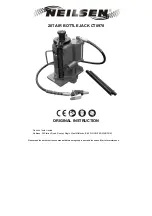
OPERATION
Lifting
1. Assemble 2 pc handle. Ensure that
spring clips align with slots.
2. Secure the load to prevent inadvertent
shifting and movement.
3. Position the jack near desired lift point.
Close the release valve by turning it
clockwise until it is firmly closed.
CAUTION: use the handle provided with this product
or an authorized replacement handle to ensure
proper release valve operation. Do not use an
extender on the air hose nor the operationg handle.
When using to loft vehicle, lift only on the
manufacturer’s recommended lift point and in
accordance with the published guidelines in your
vehicle owner’s manual. Always use jack stands to
support the load immediately after lifting.
4. Insert and secure handle into handle
sleeve. Pump handle or squeeze the lift
control valve until saddle contacts load. To
end air operation, simply release the grip on
the lift control valve.
NEVER WIRE, CLAMP OR
OTHERWISE DISABLE THE LIFT CONTROL VALVE
TO FUNCTION BY ANY MEANS OTHER THAN BY
USING THE OPERATOR’S HAND.
5. Raise load to desired height, then
immediately transfer the load to
appropriately-rated support devices such as
jack stands.
This is a lifting device only. It is designed to lift part of
the total vehicle (one wheel or axle), always wear
safety glasses when using this equipment. Center
load on saddle before lifting. Never work on, under or
around load until it is properly supported. Transfer the
load immediately to appropriate lyrated jack stands.
Do not use this product for any purpose other than
that for which it was intended. It is owner’s
responsibility to keep labels and instructional material
legible and available.Replacement labels and
menuals are available from the menufacturer. Failure
to heed these and all other warnings pertaining to this
product can result in sudden loss of lifted load
resulting in death, presonal injury or property
damage.
Lowering
1. Raise load enough to carefully remove
jack stands.
2. Inert handle onto release valve and slowly
turn handle counterclockwise, but no more
than 1/2 turn. If load fails to lower, carefully
transfer the load to another lifting device and
jack stands. Carefully remove affected jack,
and then the jack stands. Lower the load,
again by slowly turning the release valve no
more than 1/2 turn.
Be sure all tools and personnel are clear before
lowering load, dangerous dynamic shock loads are
created by quickly opening and closing the release
valve as the load is being lowered.The resulting
overload may cause hydraulic system failure which
could cause severe personal injury and/or property
damage.
3. After removing jack from under the load,
push ram and handle sleeve down to reduce
exposure to rust and contamination.
MAINTENANCE
Important: Use only a good grade hydraulic
jack oil.Avoid mixing different typer of fluid
and NEVER use brake fluid, turbine oil,
transmission fluid, motor oil or glycerin.
Improper fluid can cause premature failure of
the jack and the potential for sudden and
immediate loss of load.
Adding oil
1. With saddle fully lowered and pump piston
fully depressed, set jack in its upright, level
position. Remove oil filler plug.
2. Fill until oil is level with the filler plug hole,
reinstall oil filler plug.
Changing oil
For best performance and longest
life,replace the complete fluid supply at least
once per year.
1. With saddlefully lowered and pump piston
fully depressed, remove the oil filler plug.
2. Lay the jack, on its side and drain the fluid
into a suitable container.
Note: Dispose of hydraulic fluid in accordance with
local regulations.
3. Fill with good quality jack oil.Reinstall iol
filler plug. We recommend Mobil DTE13 or
equivalent.








